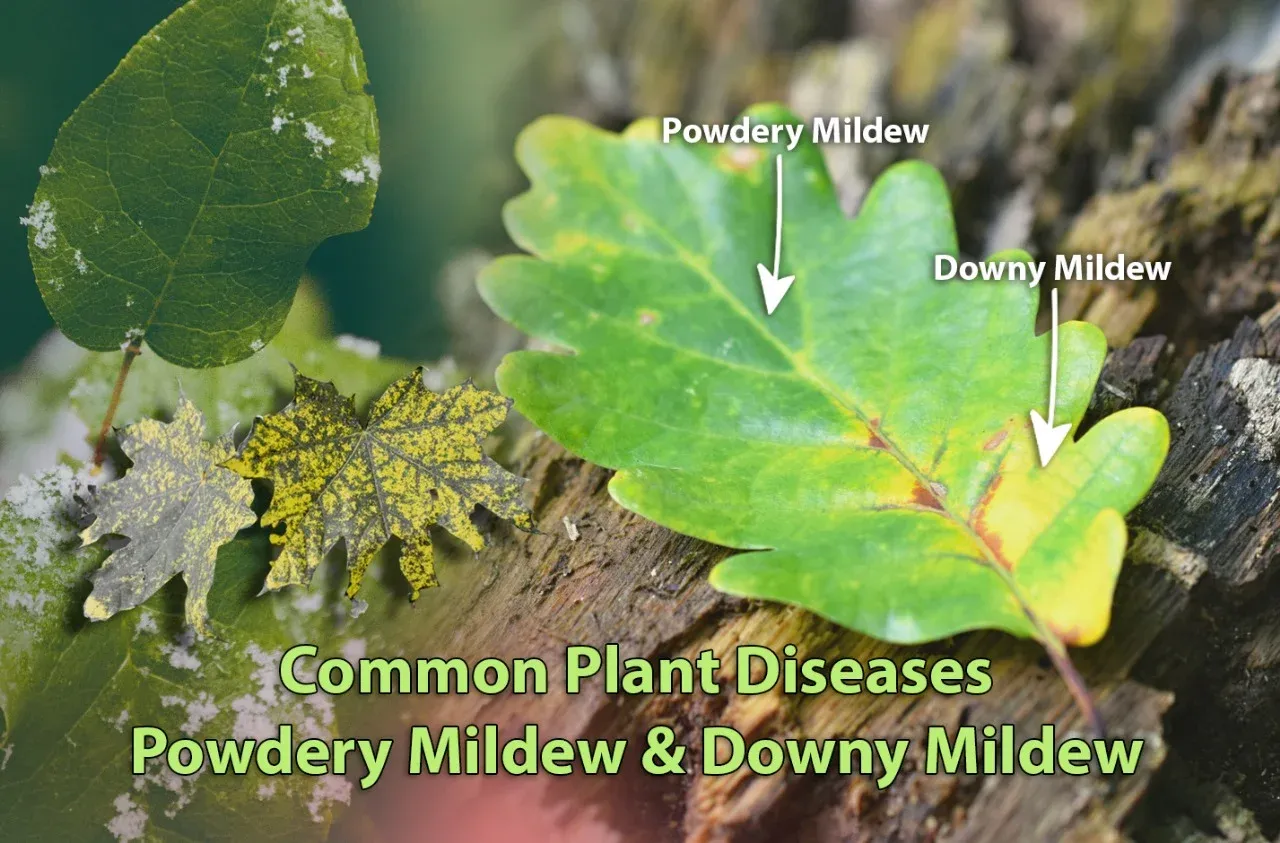- Get link
- X
- Other Apps
- Get link
- X
- Other Apps

-
Powdery Mildew & Downy Mildew
-
Powdery Mildew
Powdery mildew is a common fungus that affects a wide variety of plants. It is easily identified and appears as light grey or white powdery spots usually found on infected leaves, but can also be found underneath, or on stems, flowers, fruit, or vegetables. The spots spread and will eventually cover most of the leaves on the plant, with new plant growth being the most susceptible.
Powdery mildew thrives in warm, dry climates; however, it also needs fairly high humidity — like the warm days and cool nights in late spring to early summer. Not enough sunlight and poor air circulation also contribute to conditions that encourage powdery mildew.
Although rarely fatal, if left unchecked it can eventually cause serious harm to your plants by robbing them of water and nutrients. Most infections cause minor damage such as leaves turning yellow or becoming withered or distorted, but plants can also become weak, bloom less, and grow slower.
-
Tips for Controlling Powdery Mildew
- 1 - Inspect plants that you buy from a greenhouse before purchasing for mildew (and insects).
- 2 - Wiping off the leaves is not an effective powdery mildew treatment as it will return within days of cleaning.
- 3 - Because spores overwinter in debris all infected debris should be removed. Trim and remove infected plant parts.
- 4 - Do not till the debris into the soil or use it in the compost pile.
- 5 - Space plants are far enough apart to increase air circulation and reduce humidity.
-
-
Downy Mildew
Downy mildews are a group of closely related pathogenic ‘water molds’ that can cause major damage in the nursery, greenhouse, and landscape in the form of leaf spots, blights, and distortions.
Downy mildew is a type of oomycetes or water mold. Once considered a fungal disease. There are thousands of different types of water molds, most of which are called downy mildew. Most specialize in a particular species or a group of plants. They are a significant cause of plant pathology.
It is an obligatory parasite and has to have living plants while going through its life cycle. These plant diseases can devastate a crop and kill most of the plants within a week. It is considered an economically important group of pathogens for that reason.
-
-
Tips for Downy Mildew Treatment
-
Downy mildew needs water to survive and spread. If there is no water on your leaves, the disease cannot spread. Keep water off leaves as much as possible.
-
Because the disease overwinters on dead plant debris, be sure to clean around your plants in the fall to help prevent the disease in the following spring.
-
In the next and final blog of this series, we will discuss Blight & Canker plant diseases, keep following us on social media, and check out our in-house magazine e-crop where we explore more topics on sustainable agriculture and precision farming.
-
- Get link
- X
- Other Apps
Comments
Thank you for this insightful guide! Identifying plant diseases can be quite challenging, but your detailed explanations make it much easier to understand and tackle.
ReplyDeleteThank you for your feedback! We’re happy to hear that the guide made identifying plant diseases easier for you. At Precision Grow, we strive to simplify challenging topics. Stay tuned for more useful insights!
DeleteI've been struggling with plant diseases in my garden lately, so this guide couldn't have come at a better time! Your tips and visuals are incredibly helpful.
ReplyDeleteThank you! We're glad the guide was helpful. At Precision Grow, we aim to make managing plant diseases easier. Stay tuned for more tips!
DeleteWow, I never realized there were so many different types of plant diseases!
ReplyDeleteThank you! We're glad the guide helped you discover the variety of plant diseases. Stay tuned for more insights from Precision Grow!
DeleteI've been searching for a reliable resource on plant disease identification, and I'm so glad I stumbled upon your blog! Your clear explanations and practical tips make it easy for anyone to understand.
ReplyDeleteThank you for your kind words! We’re thrilled that you found our blog helpful. At Precision Grow, we strive to provide clear explanations and practical tips to make plant disease identification accessible for everyone. Stay tuned for more valuable resources!
DeleteI've been looking for resources to improve my gardening skills, and your blog has been a goldmine!
ReplyDeleteThank you! We’re glad our blog has been helpful in improving your gardening skills. Stay tuned for more tips from Precision Grow!
DeleteYour insights into plant disease identification are invaluable. Can't wait to read more
ReplyDeleteThank you for your feedback! We’re glad you found our insights valuable. At Precision Grow, we’re committed to providing more useful content, so stay tuned for future updates!
DeleteThanks for sharing your knowledge and helping us all become better gardeners. Excited to continue learning from you in Part 3
ReplyDeleteThank you for your kind words! We’re excited to hear that you’re finding our content helpful. At Precision Grow, we’re committed to supporting gardeners like you, and we can’t wait to share more insights in Part 3. Stay tuned!
Delete